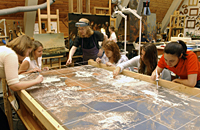>
I still remember the nerves, excitement, and stress of interviewing for graduate school last spring, and as interview time rolls around again I’ll share some advice and relate my experience at Buffalo State College.
This will sound obvious, but re-read the requirements the school has given you and be sure you have everything they want! If you aren’t sure exactly what the school would like you to bring, ask them. I called and emailed all three departments with questions on their requirements- and they were all slightly different.
I made myself a checklist ahead of time and when I was packing for the trip to be sure I didn’t leave anything out. It also made me feel more relaxed knowing that I was prepared. I interviewed at WUDPAC, NYU, and Buffalo, and by the end of March I was so sleep deprived and anxious I might have forgotten my own head 🙂
I decided to buy two large hard-sided art portfolios with shoulder straps to help transport the 2-D art I was bringing to the interview. The documentation from my pre-program conservation experience went into a three ring binder. I was lucky enough to be able to meet with WUDPAC graduates Kristin deGhetaldi and Brian Baade who kindly showed me examples of their portfolios and gave me a mock interview.
I also arranged to practice my Powerpoint presentation ahead of time in front of the wonderful scientists and conservators at the Smithsonian Museum Conservation Institute. They provided a lot of helpful feedback, caught my mistakes, and built my confidence speaking about conservation in front of a room full of people. I picked out an interview outfit ahead of time (slacks and a top) and asked for feedback on that too! I wanted something I would feel comfortable in but that looked professional and wouldn’t wrinkle.
Because I was bringing art (including breakables) and a heavy binder along with my clothes and overnight kit, I decided to drive to Buffalo (from Silver Spring, Maryland) rather than fly. I arrived the afternoon before my interview and had time to see a little of the city by car. I had arranged ahead of time to my first year student host, Gwenanne Edwards, at her apartment near campus, where I left my bags before we headed off to a potluck dinner hosted by another first year student.
Despite being nervous and not knowing anyone, the dinner was actually fun, with lots of great food. I got to chat with many of the first and second year students, and asked a lot of questions about the program, the professors, living in Buffalo, and for last-minute interview advice. It was interesting to hear what other people, including fellow interviewees, had done already, and find out where the students were going for summer internships. Everyone was very friendly and informative.
My interview was the next morning, and Gwenanne took me to school with plenty of time to spare. She gave me a tour and I took a color blindness test and had my picture taken. Finally it was my turn to interview, and we carried my portfolios, binder, bag and box into a conference room where the committee was waiting. All of the artwork was put out on a table, someone helped me load my Powerpoint presentation (saved on my flash drive), and I passed around the treatment binder.
Basically, the presentation outlined the projects I included in the binder. I was frequently interrupted with questions, which I did my best to answer. I wasn’t reading a formal script, but I did have a typed outline which helped me get back on track when I was distracted by questions.
Everyone got up to look at my art portfolio, and I answered questions about specific items. I also had a “cheat sheet” of the history, materials and techniques of my artworks in case I got flustered and forgot something (it came in handy when I was asked about the ingredients of the glaze on a ceramic pot). Then we sat back down and chatted about the program; I asked a few more questions, talked about my background and interests, someone asked how I felt about snow- it was very relaxed, and I felt that the committee was interested and welcoming. With the interview over, we packed everything up again and Gwenanne helped me load the portfolios back into my car for the drive home. As soon as I got back I sent a thank you to the committee, and to my student host, and settled in to wait for a decision.
Asking questions is a recurring theme in this blog, and I’ll repeat the advice- ask questions! I’ve found that conservators are friendly and helpful, and like to share what they know. Rose Daly also wrote a post about interviewing here and you can ask other current and former students about their experiences. Personally I owe a great deal to all the people who contributed their knowledge and advice to help me show the committee what I’d done and what I knew.
Good luck!







